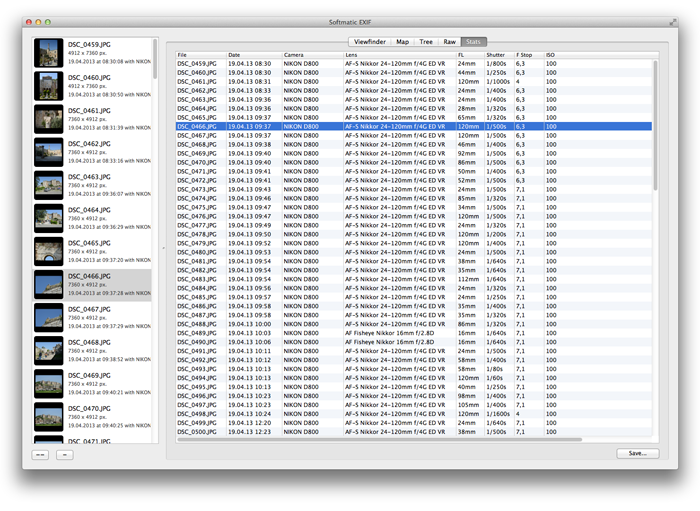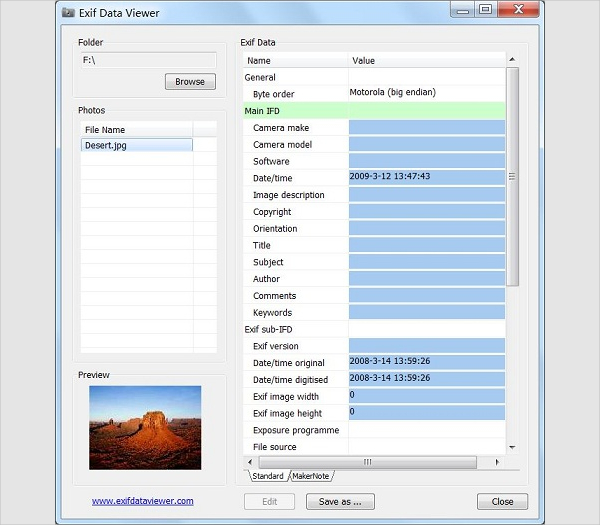

- EXIF DATA VIEWER FOR MAC MAC OS X
- EXIF DATA VIEWER FOR MAC FULL
- EXIF DATA VIEWER FOR MAC ISO
- EXIF DATA VIEWER FOR MAC FREE
- EXIF DATA VIEWER FOR MAC WINDOWS
This gives plenty of information but can be a slow way of doing things because you have to wait for your photo to upload to the website, which can take quite some time if it's a big file. Online Metadata Viewers and Browser Pluginsįinally, you can view your metadata online using a site like Jeffrey's Exif viewer. Apart from GIMP these can be quite expensive, so they're not worth buying just to view metadata, but if you already own them then they're a convenient way to do it. These include Photoshop, Photoshop Elements, Lightroom, iPhoto, and GIMP. Many of the top graphics programs have EXIF management built in. Other good tools are Opanda IExif, IrfanView's Metadata plugin, and KUSO Exif Viewer, all of which are freeware as well.
EXIF DATA VIEWER FOR MAC FREE
It's simple, free to download, and shows more information than other EXIF tools. My favourite dedicated tool is ExifTool with the GUI plugin. There are many great programs that you can use, ranging from simple, dedicated EXIF viewers right up to high-end graphics editing software.
EXIF DATA VIEWER FOR MAC FULL
If you want to access the full list of EXIF tags you'll need to use some more advanced software.

You won't see the full list of properties but you will get the most important ones, and this is often all you'll need. This is the quickest and easiest way to read your photo's metadata. Depending on which file manager you're using you may need to switch to a different information tab. Linux - Right-click the file and choose "Properties".
EXIF DATA VIEWER FOR MAC MAC OS X
Mac OS X - Right-click on the picture, click "Get Info", and expand the "More Info" section.
EXIF DATA VIEWER FOR MAC WINDOWS
Windows - Right-click on an image, select "Properties", and switch to the "Details" tab. You can view EXIF info directly from your operating system's file manager: There are a number of ways to access your photos' EXIF data, depending on how much information you need to view: Most of the values listed are self-explanatory, easy to read, and familiar to most photographers - EXIF isn't quite so daunting after all! As you can see, it contains detailed information about the camera, the settings used for this shot, and the final image itself.

The following screenshot shows some sample EXIF data from a photo I took recently. Luckily camera manufacturers have thought of this and come up with their own equivalents which do support RAW, and when you later save the file as a JPEG that data will be converted to EXIF and stored with it. Usually this isn't a problem, since most people will tend to shoot in JPEG, but it does mean that if you set your camera to RAW mode you won't be able to capture EXIF data. Over time this technical knowledge will help you recognise and correct similar problems before they occur, and become more familiar with your camera's settings.ĮXIF is somewhat limited in that it is only supported by two image formats - JPEG and TIFF.
EXIF DATA VIEWER FOR MAC ISO
For example, you might notice that a shot of a runner has turned out a bit blurry, so you can examine the metadata to check your shutter speed, aperture, ISO speed and so on, and decide how you could do things differently in future. This can be immensely useful when you're reviewing your pictures. This information is known as "metadata" and can include things like the date and time the shot was taken, camera settings like shutter speed and focal length, and copyright information. However, I was pleasantly surprised to discover that it's actually very simple, and can help you improve your photography in a very real way.ĮXIF stands for "exchangeable image file format", which doesn't really give you any clues as to what it actually is, but in a nutshell it allows you to store certain information within your photos. I was the same way for a long time - it sounded like it was probably complicated and of little practical use. If you've been into digital photography for any length of time you may have heard of EXIF data, although you might not know what it is or why you'd want to use it.


 0 kommentar(er)
0 kommentar(er)
